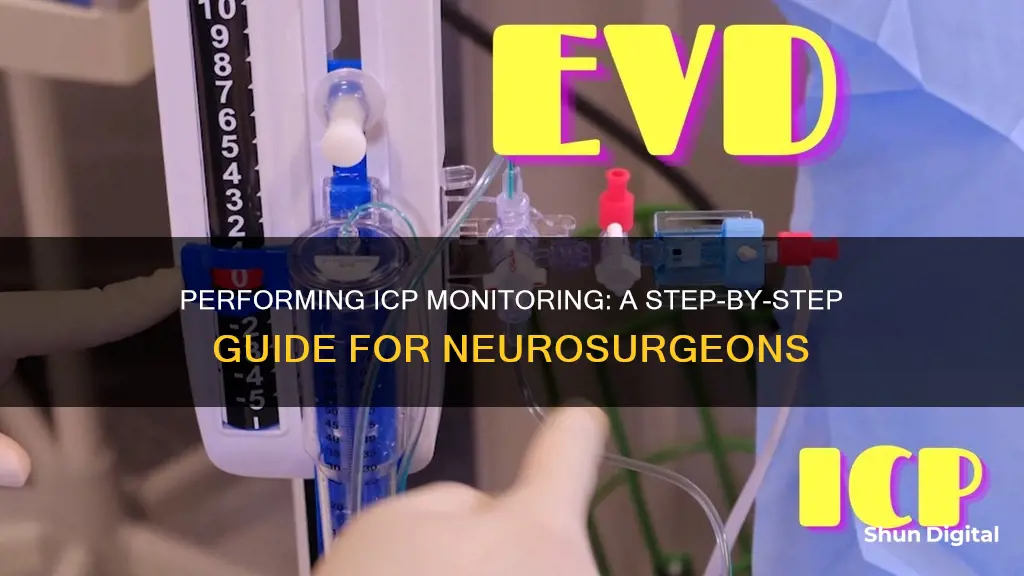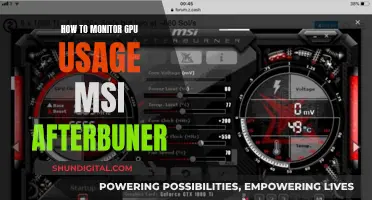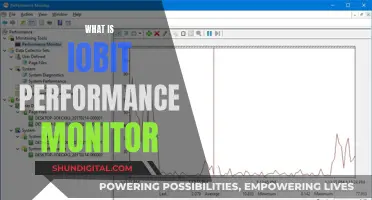
Intracranial pressure (ICP) monitoring is a diagnostic test that helps doctors determine if high or low cerebrospinal fluid (CSF) pressure is causing a patient's symptoms. The test involves inserting a small pressure-sensitive probe through the skull to directly measure the pressure in the patient's head. This procedure is often performed on patients with life-threatening neurological emergencies, such as severe head injuries, brain tumours, or nervous system diseases.
There are several methods for performing ICP monitoring, including invasive and non-invasive techniques. Invasive techniques include inserting an intraventricular catheter or a subdural screw (bolt) through the skull and into the brain. Non-invasive techniques include physical examination, neuroimaging, optic nerve sheath diameter assessment, and transcranial Doppler (TCD). ICP monitoring allows doctors to make informed decisions about treatment options, such as draining CSF, changing ventilator settings, or administering medications.
ICP monitoring is a crucial tool in managing severe traumatic brain injuries and can help prevent potentially harmful aggressive treatments. By continuously monitoring ICP, clinicians can detect intermittent abnormalities, correlate pressure readings with symptoms, and take timely treatment measures to improve patient outcomes.
| Characteristics | Values |
|---|---|
| Purpose | To determine if high or low cerebrospinal fluid (CSF) pressure is causing symptoms |
| Test type | Diagnostic |
| Test procedure | Invasive or non-invasive |
| Invasive procedure | Insertion of a device inside the head |
| Non-invasive procedure | Physical examination, neuroimaging, optic nerve sheath diameter assessment, transcranial Doppler, otic methods, acoustic methods, near-infrared spectroscopy, electroencephalogram, etc. |
| Invasive device types | Intraventricular catheter, subdural screw (bolt), epidural sensor, intraparenchymal pressure microsensor, external ventricular drain, subarachnoid bolt, epidural bolt |
| Normal ICP range | 1-20 mm Hg or 5-15 mm Hg |
| High ICP treatment | Drain CSF, change ventilator settings, administer medication |
| High ICP risks | Brain herniation, brain tissue damage, catheter misplacement, risks of general anesthesia |
What You'll Learn
- ICP monitoring methods: intraventricular catheter, subdural screw, epidural sensor
- ICP monitoring indications: traumatic brain injury, hydrocephalus, brain tumours, brain surgery
- ICP monitoring preparation: blood and urine tests, stopping blood thinners, local anaesthetic
- ICP monitoring risks: brain herniation, brain tissue damage, infection, device malfunction
- ICP monitoring results: high ICP can be treated by draining CSF, changing ventilator settings, medication

ICP monitoring methods: intraventricular catheter, subdural screw, epidural sensor
Intraventricular Catheter
To insert an intraventricular catheter, a hole is drilled through the skull of the patient, who is under general or local anaesthesia. The catheter is then inserted through the brain into the lateral ventricle, which contains cerebrospinal fluid (CSF). This method is considered the most accurate form of ICP monitoring. The catheter can also be used to drain excess CSF. However, it may be challenging to insert when intracranial pressure is high.
Subdural Screw
This method is used when immediate monitoring is required. A hollow screw is inserted through a hole drilled in the skull and placed through the membrane that protects the brain and spinal cord. This allows the sensor to record from inside the subdural space.
Epidural Sensor
This procedure is less invasive than the intraventricular catheter and subdural screw methods. An epidural sensor is inserted between the skull and dural tissue through a hole drilled in the skull. However, it cannot remove excess CSF.
ICP Monitoring Procedure
Before the procedure, the area is shaved, cleansed with antiseptic, and then surgically cut open. The skin is pulled back to expose the skull, and a drill is used to cut through the bone.
ICP monitoring is typically performed on patients with life-threatening neurological emergencies, such as severe head injuries, brain/nervous system diseases, or post-surgery complications.
Highlander LE Plus: Blind Spot Monitoring Feature Explained
You may want to see also

ICP monitoring indications: traumatic brain injury, hydrocephalus, brain tumours, brain surgery
Intracranial pressure (ICP) monitoring is a diagnostic test that helps doctors determine if high or low cerebrospinal fluid (CSF) pressure is causing a patient's symptoms. ICP monitoring is indicated for traumatic brain injury (TBI), hydrocephalus, brain tumours, and brain surgery.
Traumatic Brain Injury
ICP monitoring is recommended for patients with TBI at risk for intracranial hypertension, including those in a coma with a Glasgow Coma Scale score of less than 8 and an abnormal head CT scan. This includes patients with mass lesions, swelling, midline shift, and compressed basal cisterns. ICP monitoring is also recommended if two or more of the following are present: age over 40, unilateral or bilateral motor posturing, or episodes of systolic blood pressure less than 90 mmHg.
Hydrocephalus
ICP monitoring is indicated for patients with hydrocephalus or conditions at high risk of developing hydrocephalus, such as space-occupying lesions or subarachnoid haemorrhage.
Brain Tumours
ICP monitoring is recommended for patients with brain tumours, particularly those at risk for intracranial hypertension.
Brain Surgery
ICP monitoring is recommended following brain surgery, especially craniotomy for a mass lesion, and when there are associated factors such as hypoxia, hypotension, pupil abnormalities, midline shift, or brain swelling.
ICP monitoring techniques include invasive and non-invasive methods. The most common invasive techniques are intraparenchymal strain gauge or fibre optic monitors and intraventricular monitors using a ventriculostomy (considered the gold standard). Non-invasive methods include optic nerve sheath diameter measurement, transcranial Doppler ultrasound, and near-infrared spectroscopy, among others.
The benefits of ICP monitoring include the ability to guide medical and surgical therapy, improve the efficiency of care, and potentially improve patient outcomes. However, there are risks and complications associated with ICP monitoring, including infection, intracranial haemorrhage, and device malfunction or difficulty with placement.
Mounting Your Ultrawide: A Step-by-Step Guide for ASUS Monitors
You may want to see also

ICP monitoring preparation: blood and urine tests, stopping blood thinners, local anaesthetic
ICP Monitoring Preparation
Blood and Urine Tests
3 to 7 days before your hospital admission, you will be scheduled for a series of tests. These may include blood and urine tests to check for infections or a tendency to bleed and ensure it is safe for the procedure to go ahead.
Stopping Blood Thinners
If you are taking any blood thinners, such as antiplatelet agents or anticoagulants (e.g. Plavix, Coumadin), you will need to stop taking them after discussing this with your doctor.
Local Anaesthetic
Notify your doctor if you have an allergy to any local anaesthetic (e.g. lidocaine), as this may be administered during the procedure.
Monitoring Shop Usage: Strategies for Success
You may want to see also

ICP monitoring risks: brain herniation, brain tissue damage, infection, device malfunction
Intracranial pressure (ICP) monitoring is a procedure that involves inserting a device into the skull to measure and monitor the pressure inside. While ICP monitoring is a valuable tool in managing severe traumatic brain injuries, it is not without risks. Some of the potential risks and complications associated with ICP monitoring include brain herniation, brain tissue damage, infection, and device malfunction. Here are 4-6 paragraphs further discussing these risks:
Brain Herniation:
Brain herniation is a serious and potentially life-threatening complication that can occur during ICP monitoring. It happens when the brain tissue shifts or moves abnormally, often due to increased intracranial pressure. This shifting can compress vital structures within the skull, such as blood vessels and nerves, leading to severe neurological deficits. Brain herniation is a medical emergency that requires immediate intervention to prevent permanent damage or death.
Brain Tissue Damage:
ICP monitoring devices are inserted into delicate brain tissue, and improper placement or technical errors can result in direct trauma to the brain. Additionally, if the device is not placed correctly, it may not provide accurate readings, leading to mismanagement of intracranial pressure and potential harm to the patient. Brain tissue can also be damaged by infection or hemorrhage associated with the device, further complicating the patient's condition.
Infection:
Infection is a significant risk associated with ICP monitoring. The insertion of a foreign body into the skull creates an opportunity for bacteria to enter, leading to infections such as ventriculitis or meningitis. The overall risk of infection is estimated to be around 5%, and certain factors, such as open head injuries, intraventricular monitor placement, and prolonged monitoring, can increase this risk. Prophylactic antibiotics are often administered to reduce the risk of infection, but they may not always be effective.
Device Malfunction:
Device malfunction is another potential risk of ICP monitoring. This can include technical failures, such as difficulty tapping the ventricle or misplacement of the device. Drift, or changes in the baseline pressure reading over time, can also occur, affecting the accuracy of ICP measurements. Additionally, blockages in the fluid-filled catheters used in some ICP monitoring systems can lead to inaccurate or false ICP recordings. Device malfunction can result in inappropriate or delayed treatment decisions, potentially harming the patient.
ICP monitoring is a valuable tool in the management of severe traumatic brain injuries, but it is important to be aware of and carefully manage these risks to ensure the best possible outcome for patients.
Monitoring JVM Memory Usage on Linux: A Practical Guide
You may want to see also

ICP monitoring results: high ICP can be treated by draining CSF, changing ventilator settings, medication
ICP Monitoring Results: Treating High ICP
Intracranial pressure (ICP) monitoring is a diagnostic test that helps doctors determine if high or low cerebrospinal fluid (CSF) pressure is causing a patient's symptoms. The test involves inserting a small pressure-sensitive probe through the skull to measure the pressure in the head directly. High ICP can be life-threatening and requires immediate treatment. Here are some ways to treat high ICP:
Drainage of CSF
One way to treat high ICP is by draining CSF through a catheter. This method is known as CSF drainage or external ventricular drainage and can help reduce the pressure inside the skull.
Changing Ventilator Settings
For patients who are on a respirator, changing the ventilator settings can help treat high ICP. Hyperventilation, for example, can induce cerebral vasoconstriction and reduce cerebral blood volume, thereby lowering ICP. However, hyperventilation should only be used as a bridge to more definitive therapy as it has limited effectiveness and potential side effects.
Medication
Certain medications can be administered intravenously to treat high ICP. For instance, osmotic agents such as mannitol or hypertonic saline can be used to temporarily reduce ICP. Additionally, sedatives and analgesics such as propofol and opioids can be given to the patient.
Surgical Options
In some cases, surgical options may be considered to treat high ICP. Decompressive craniectomy, for instance, can be performed to reduce intracranial hypertension. However, this procedure should be undertaken timely and in subjects with a potentially acceptable prognosis.
Other Treatments
Other treatments for high ICP include head-up positioning of the patient, maintaining hemodynamic stability, normothermia, and crystalloids as maintenance fluids. Additionally, addressing any reversible causes or systemic abnormalities that may be affecting intracranial volumes and causing raised ICP is crucial before starting ICP-directed therapies.
Lace Monitor Buying: Where to Purchase Your New Pet
You may want to see also







